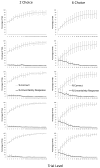Capuchin monkeys (Cebus apella) modulate their use of an uncertainty response depending on risk
- PMID: 26551351
- PMCID: PMC4710549
- DOI: 10.1037/xan0000080
Capuchin monkeys (Cebus apella) modulate their use of an uncertainty response depending on risk
Abstract
Metacognition refers to thinking about thinking, and there has been a great deal of interest in how this ability manifests across primates. Based on much of the work to date, a tentative division has been drawn with New World monkeys on 1 side and Old World monkeys and apes on the other. Specifically, Old World monkeys, apes, and humans often show patterns reflecting metacognition, but New World monkeys typically do not, or show less convincing behavioral patterns. However, recent data suggest that this difference may relate to other aspects of some experimental tasks. For example, 1 possibility is that risk tolerance affects how capuchin monkeys, a New World primate species, tend to perform. Specifically, it has recently been argued that on tasks in which there are 2 or 3 options, the "risk" of guessing is tolerable for capuchins because there is a high probability of being correct even if they "know they do not know" or feel something akin to uncertainty. The current study investigated this possibility by manipulating the degree of risk (2-choices vs. 6-choices) and found that capuchin monkeys used the uncertainty response more on 6-choice trials than on 2-choice trials. We also found that rate of reward does not appear to underlie these patterns of performance, and propose that the degree of risk is modulating capuchin monkeys' use of the uncertainty response. Thus, the apparent differences between New and Old World monkeys in metacognition may reflect differences in risk tolerance rather than access to metacognitive states.
(c) 2016 APA, all rights reserved).
Figures






Similar articles
-
Capuchin monkeys (sometimes) go when they know: Confidence movements in Sapajus apella.Cognition. 2020 Jun;199:104237. doi: 10.1016/j.cognition.2020.104237. Epub 2020 Feb 26. Cognition. 2020. PMID: 32112968
-
Sequential responding and planning in capuchin monkeys (Cebus apella).Anim Cogn. 2012 Nov;15(6):1085-94. doi: 10.1007/s10071-012-0532-8. Epub 2012 Jul 17. Anim Cogn. 2012. PMID: 22801861 Free PMC article.
-
Evaluation of decision-making behavior under uncertainty in capuchin monkeys (Sapajus apella) and humans (Homo sapiens) using a modified Balloon Analogue Risk Task.J Comp Psychol. 2024 May;138(2):88-98. doi: 10.1037/com0000368. Epub 2023 Dec 14. J Comp Psychol. 2024. PMID: 38095928
-
How different are robust and gracile capuchin monkeys? An argument for the use of sapajus and cebus.Am J Primatol. 2012 Apr;74(4):273-86. doi: 10.1002/ajp.22007. Epub 2012 Feb 10. Am J Primatol. 2012. PMID: 22328205 Review.
-
Capuchin monkey research priorities and urgent issues.Am J Primatol. 2014 Aug;76(8):705-20. doi: 10.1002/ajp.22269. Epub 2014 Mar 25. Am J Primatol. 2014. PMID: 24668460 Review.
Cited by
-
Rats know when they remember: transfer of metacognitive responding across odor-based delayed match-to-sample tests.Anim Cogn. 2017 Sep;20(5):891-906. doi: 10.1007/s10071-017-1109-3. Epub 2017 Jul 1. Anim Cogn. 2017. PMID: 28669115 Free PMC article.
-
Chimpanzees Rarely Settle on Consistent Patterns of Play in the Hawk Dove, Assurance, and Prisoner's Dilemma Games, in a Token Exchange Task.Anim Behav Cogn. 2019 Feb;6(1):48-70. doi: 10.26451/abc.06.01.04.2019. Anim Behav Cogn. 2019. PMID: 31245532 Free PMC article.
-
When does metacognition evolve in the opt-out paradigm?Anim Cogn. 2024 Oct 22;27(1):68. doi: 10.1007/s10071-024-01910-5. Anim Cogn. 2024. PMID: 39436474 Free PMC article.
-
Uncertainty monitoring in Eurasian jays (Garrulus glandarius).Anim Cogn. 2025 May 15;28(1):37. doi: 10.1007/s10071-025-01960-3. Anim Cogn. 2025. PMID: 40372593 Free PMC article.
-
Metacognition in nonhuman primates: a review of current knowledge.Primates. 2025 Jan;66(1):9-25. doi: 10.1007/s10329-024-01169-x. Epub 2024 Dec 14. Primates. 2025. PMID: 39673592 Free PMC article. Review.
References
-
- Adams A, Santi A. Pigeons exhibit higher accuracy for chosen memory tests than for forced memory tests in duration matching-to-sample. Learning and Behavior. 2011;39:1–11. - PubMed
-
- Beran MJ. Capuchin monkeys (Cebus apella) succeed in a test of quantity conservation. Animal Cognition. 2008;11:109–116. - PubMed
Publication types
MeSH terms
Grants and funding
LinkOut - more resources
Full Text Sources
Other Literature Sources

